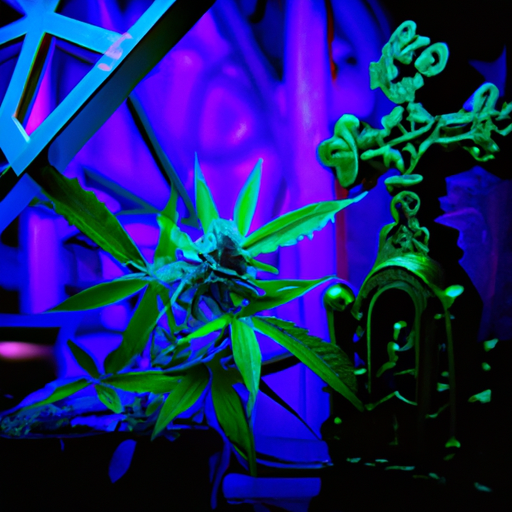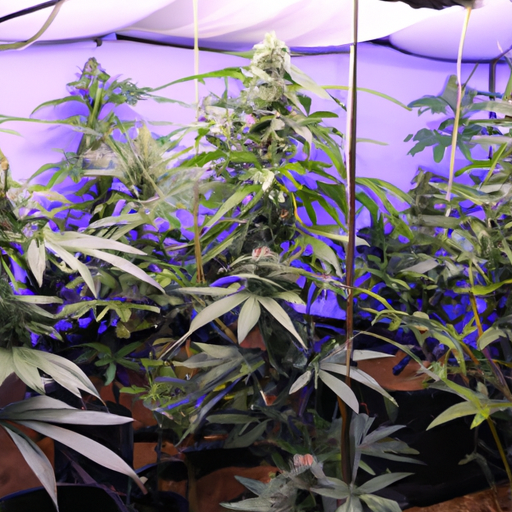Grow Your Best Crop Yet: Expert Tips for Cultivating High-Quality Cannabis at Home
Welcome, fellow cannabis enthusiasts, to a journey that will unlock the secrets of cultivating high-quality cannabis right in the comfort of your own home. In this article, we will dive deep into the world of cannabis cultivation, sharing valuable insights and expert advice on how to grow your best crop yet.
But before we embark on this exciting adventure, let's take a moment to appreciate the remarkable relationship between cannabis and our overall health and well-being. Cannabis, known by many names such as weed, ganja, or marijuana, has captivated the attention of both ancient healers and modern scientists for its potential therapeutic benefits.
Research has shown that cannabis possesses a diverse range of medicinal properties that can potentially aid in pain management, reduce inflammation, alleviate anxiety and depression, improve sleep, and enhance overall quality of life. It's no wonder that this magical herb has gained such recognition in the medical field, particularly in states like New York where its use for medical purposes is permitted.
In the first section of this article, "Unveiling the Healing Power of Cannabis: Exploring its Medicinal Properties and Potential Benefits," we will delve into the various compounds found in cannabis, such as CBD and THC, and how they interact with our body's endocannabinoid system to promote healing and balance. We will also explore the potential benefits of cannabis in treating specific health conditions and discuss the latest research and studies on this subject.
But the healing power of cannabis is not a recent discovery. Throughout history, cannabis has been revered for its medicinal properties and spiritual significance. In the second section, "From Ancient Medicine to Modern Science: Tracing the Historical Significance of Cannabis in Healing Practices," we will take a fascinating journey through time, exploring how different cultures and civilizations have utilized cannabis for its healing properties. From the ancients to the present day, cannabis has played a crucial role in the realm of medicine.
Now, let's get our hands dirty and dive into the practical aspects of cannabis cultivation. In the third section, "Cultivating Cannabis at Home: Tips and Tricks for Growing High-Quality Plants for Medicinal Use," we will provide you with expert advice on how to create the optimal growing environment, select the right strains for your needs, and master the art of nurturing healthy, potent plants. Whether you're a seasoned grower or a beginner taking your first steps, these tips and tricks will empower you to grow your best crop yet.
So, fellow cannabis enthusiasts, get ready to embark on a journey of discovery, as we uncover the secrets of cannabis cultivation and explore its potential for healing and well-being. Let's harness the power of this magical plant and optimize our health in a holistic manner. Get ready to grow your best crop yet and unlock the full potential of cannabis for a brighter, healthier future.
- 1. "Unveiling the Healing Power of Cannabis: Exploring its Medicinal Properties and Potential Benefits"
- 2. "From Ancient Medicine to Modern Science: Tracing the Historical Significance of Cannabis in Healing Practices"
- 3. "Cultivating Cannabis at Home: Tips and Tricks for Growing High-Quality Plants for Medicinal Use"
1. "Unveiling the Healing Power of Cannabis: Exploring its Medicinal Properties and Potential Benefits"

Unveiling the Healing Power of Cannabis: Exploring its Medicinal Properties and Potential Benefits
Cannabis, also known as weed, ganja, or marijuana, has been used for centuries by various cultures for its medicinal properties. In recent years, there has been a resurgence of interest in the therapeutic benefits of cannabis, particularly in the field of alternative medicine. From pain management to reducing inflammation, alleviating anxiety and depression, improving sleep, and enhancing overall quality of life, cannabis has shown promising potential in treating a wide range of health conditions.
One of the most well-known uses of cannabis is its ability to alleviate chronic pain. The active compounds in cannabis, known as cannabinoids, interact with the body's endocannabinoid system, which plays a crucial role in regulating pain perception. Research has shown that cannabis can help reduce pain associated with conditions such as arthritis, fibromyalgia, and multiple sclerosis.
In addition to pain management, cannabis has also been found to have anti-inflammatory properties. Chronic inflammation is a common underlying factor in many health conditions, including autoimmune diseases, cardiovascular diseases, and neurodegenerative disorders. The cannabinoids in cannabis can help modulate the immune response and reduce inflammation, potentially providing relief for those suffering from these conditions.
Anxiety and depression are two mental health disorders that affect millions of people worldwide. Traditional treatments for these conditions often come with undesirable side effects. However, cannabis has shown promise as a natural alternative. Certain cannabinoids, such as CBD (cannabidiol), have been found to have anxiolytic and antidepressant effects, helping to alleviate symptoms and improve overall mood.
Another area where cannabis has shown potential is in improving sleep quality. Insomnia and sleep disorders can have a significant impact on an individual's overall health and well-being. Research suggests that cannabis may help regulate sleep patterns and promote deeper, more restful sleep. This can be especially beneficial for those who struggle with chronic sleep issues.
It's important to note that while cannabis has been used for thousands of years for medicinal purposes, its use should be approached with caution and under the guidance of a healthcare professional. The dosage, strain, and method of consumption can vary depending on the individual and the condition being treated. Additionally, the legal status of cannabis varies from country to country and even within different states or regions.
In conclusion, the healing power of cannabis is a topic that continues to be explored and researched. From its ancient use as a medicinal herb to its potential in modern medicine, cannabis offers a wide range of medicinal properties and potential benefits. Whether it's for pain management, reducing inflammation, alleviating anxiety and depression, improving sleep, or enhancing overall quality of life, cannabis has the potential to play a significant role in holistic health and well-being.
So, if you're in New York and looking for alternative medical options, consider exploring the potential benefits of cannabis. Its long-standing history as a medicinal herb, coupled with the latest scientific research, makes it an intriguing option for those seeking natural and holistic healing methods. Remember, though, to always consult with a medical professional and adhere to the legal regulations in your area. Embrace the healing power of cannabis and unlock its magical potential for your well-being.
2. "From Ancient Medicine to Modern Science: Tracing the Historical Significance of Cannabis in Healing Practices"

From Ancient Medicine to Modern Science: Tracing the Historical Significance of Cannabis in Healing Practices
Cannabis, also known as weed, ganja, or marijuana, has a rich history deeply intertwined with healing practices. Its use as a medicinal herb dates back thousands of years, with evidence of its therapeutic properties found in ancient civilizations across the globe. From the spiritual rituals of the ancients to the advancements of modern science, cannabis has played a pivotal role in promoting health and well-being.
In ancient times, cannabis was revered for its magical and healing properties. In regions such as India and China, it was considered a sacred plant with profound spiritual significance. Cannabis was used in religious ceremonies, meditation practices, and as an aid to achieve altered states of consciousness. The ancients believed that cannabis had the power to connect individuals with the divine and bring about spiritual enlightenment.
As the years passed, cannabis continued to be utilized for its medicinal benefits. Ancient texts and manuscripts from various cultures, including the Egyptians, Greeks, and Persians, documented the use of cannabis for treating a wide range of ailments. It was used to alleviate pain, reduce inflammation, and promote relaxation. The ancients recognized its potential as an analgesic, anti-inflammatory, and sedative, laying the foundation for its future use in modern medicine.
Fast forward to the present day, and we find ourselves amidst a resurgence of interest in the medicinal properties of cannabis. With the legalization of medical marijuana in many parts of the world, including New York, there has been a renewed focus on understanding the therapeutic potential of this ancient herb. Medical professionals and researchers are now delving into the scientific aspects of cannabis, exploring its chemical compounds and their effects on the human body.
Studies have shown that cannabis contains various cannabinoids, such as THC and CBD, which interact with the body's endocannabinoid system. This system plays a crucial role in regulating various physiological processes, including pain perception, immune function, and mood. By targeting specific receptors in the body, cannabis compounds can modulate these processes and potentially provide relief from a range of health conditions.
Medical cannabis has shown promise in managing chronic pain, reducing inflammation, alleviating symptoms of anxiety and depression, improving sleep quality, and enhancing overall quality of life. Research is ongoing, with scientists continuously uncovering new insights into the potential medical benefits of cannabis.
In conclusion, the historical significance of cannabis in healing practices cannot be understated. From its use in ancient spiritual rituals to its current exploration in modern science, cannabis has been a source of healing and well-being for millennia. As we continue to unlock the therapeutic potential of this remarkable plant, it is essential to approach its use with knowledge, respect, and a commitment to further scientific research. By harnessing the healing properties of cannabis, we can optimize our health and thrive in a holistic manner.
3. "Cultivating Cannabis at Home: Tips and Tricks for Growing High-Quality Plants for Medicinal Use"

Cultivating Cannabis at Home: Tips and Tricks for Growing High-Quality Plants for Medicinal Use
Growing cannabis at home can be a fulfilling and rewarding experience, especially when you have access to high-quality plants for medicinal use. Whether you're a seasoned grower or just starting out, here are some valuable tips and tricks that can help you cultivate the best crop of cannabis right in the comfort of your own home.
1. Start with the Right Genetics:
Choosing the right strain of cannabis is crucial for achieving the desired medicinal effects. Different strains have varying levels of cannabinoids and terpenes, which are responsible for the plant's therapeutic properties. Research different strains and select those that align with your specific medical needs. For example, if you're seeking pain relief, strains high in CBD (cannabidiol) may be more suitable.
2. Create the Optimal Environment:
Cannabis plants thrive in specific environmental conditions. Ensure your growing space provides the right temperature, humidity, and lighting. Optimal temperature ranges between 70-85°F (21-29°C) during the day and slightly cooler at night. Maintain humidity levels between 40-60% to prevent mold and mildew. Consider investing in grow lights or natural sunlight exposure for the appropriate lighting cycle.
3. Provide Adequate Nutrients:
Like any other plant, cannabis requires proper nutrition to grow healthy and robust. Use a high-quality soil or nutrient-rich growing medium to provide essential nutrients. Consider using organic fertilizers or nutrient solutions specifically formulated for cannabis cultivation. Remember to follow the recommended dosage and feeding schedule to avoid over or underfeeding your plants.
4. Manage Watering and Drainage:
Proper watering techniques are critical in preventing root rot and other water-related issues. Allow the soil to dry out slightly between watering to avoid waterlogged conditions. Use a well-draining potting mix and ensure proper drainage to prevent excess water accumulation. Monitor the moisture levels and adjust your watering schedule accordingly.
5. Implement Training Techniques:
Training techniques such as topping, pruning, and low-stress training (LST) can help enhance plant growth and maximize yield. These methods involve strategically manipulating the plant's structure to promote even canopy development, increased bud production, and better light penetration. Research and practice different training techniques based on your growing space and desired outcome.
6. Monitor and Control Pests:
Pests can pose a significant threat to your cannabis plants and affect their overall health and quality. Regularly inspect your plants for signs of pests such as spider mites, aphids, or fungus gnats. Implement preventive measures like maintaining cleanliness, using organic pest control methods, and introducing beneficial insects to keep pests at bay.
7. Harvest at the Right Time:
Knowing when to harvest your cannabis plants is crucial for achieving optimal potency and flavor. Monitor the trichomes (the resinous glands on the buds) using a magnifying glass or microscope. Harvest when the trichomes have turned milky white or amber, depending on the desired effect. Proper curing and drying techniques are also essential for preserving the quality and potency of the harvested buds.
By following these tips and tricks, you can cultivate high-quality cannabis plants at home for medicinal use. Remember to always stay informed, experiment, and adapt your cultivation techniques based on your specific needs and growing conditions. Happy growing!
FAQs:
1. Can I grow cannabis indoors?
Yes, you can successfully grow cannabis indoors by creating the right environment with proper lighting, temperature, humidity, and ventilation.
2. How long does it take to grow cannabis at home?
The time it takes to grow cannabis at home can vary depending on the strain, growing conditions, and desired outcome. On average, it takes around 8-12 weeks from seed to harvest.
3. Are there any legal restrictions on growing cannabis at home?
The legality of growing cannabis at home varies from country to country and state to state. It's important to familiarize yourself with the local laws and regulations regarding home cultivation before starting.
In conclusion, cultivating cannabis at home for medicinal use can be a fulfilling and rewarding journey. With the right genetics, optimal environment, proper nutrients, and cultivation techniques, you can grow high-quality cannabis plants that offer therapeutic benefits and enhance your overall well-being. Remember to always prioritize safety, legality, and responsible consumption.
